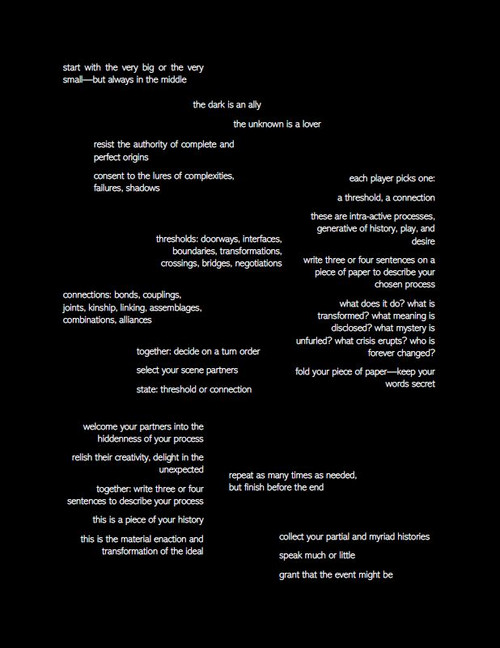Postmortem: Fidelity and Application

umbral / rhizome started as one thing, and then quickly became something else. Indeed, the crypt arrested me before I ever entertained the thought of a particular cryptid. Why do we enjoy such stories? Why do we like to be spooked? Why do we speculate upon the dark? These are the questions the Cryptid Jam raised for me, questions that brought me to two concepts that have hounded me for some time now: fidelity (Badiou) and application (Gadamer).
It's late and I don't have the energy to do a thorough interpretive work, so I'll leave this postmortem in a mostly citational form. First, Badiou (Being and Event, 233):
"First, a fidelity is always particular, insofar as it depends on an event. There is no general faithful disposition. Fidelity must now be understood in any way as a capacity, a subjective quality, or a virtue. Fidelity is a situated operation which depends on the examination of situations. Fidelity is a functional relation to the event.
Second, a fidelity is not a term-multiple of the situation, but, like the count-as-one, an operation, a structure. What allows us to evaluate a fidelity is its result: the count-as-one of the regulated effects of an event. Strictly speaking, fidelity is not. What exists are the groupings that it constitutes of one-multiples which are marked, in one way or another, by the evental happening.
Third, since a fidelity discerns and groups together presented multiples, it counts the parts of a situation. The result of faithful procedures is included in the situation. Consequently, fidelity operates in a certain sense on the terrain of the state of the situation. A fidelity can appear, according to the nature of its operations, like a counter-state, or a sub-state. There is always something institutional in a fidelity, if institution is understood here, in a very general manner, as what is found in the space of representation, of the state, of the count-of-the-count; as what has to do with inclusions rather than belongings."
And second, Gadamer (Truth and Method, 341):
"The task of concretizing something universal and applying it to oneself seems, however, to have a very different function in the historical sciences. If we ask what application means here and how it occurs in the kind of understanding undertaken in the human sciences, we can acknowledge that a certain class of traditionary material is applied in the same way the jurist does in regard to the law and the theologian the proclamation. Just as in the one case the judge seeks to dispense justice and in the other the preacher to proclaim salvation, and as, in both, the meaning of what is proclaimed finds its fullest realization in the proclamation of justice and the proclamation of the gospel, so in the case of a philosophical text or a work of literature we can see that these texts require a special activity of the reader and interpreter and that we do not have the freedom to adopt a historical distance toward them. It will be seen that here understanding always involves applying the meaning understood."
The cryptid is the hidden animal, the animal that finds its existence in hiddenness, encryption, cryptography. It can never quite detach from its background, nor pretend to the loftiness of transcendental reflection. The cryptid is always in the dark.
But when we read Badiou and Gadamer, we see that transcendental reflection is an abstraction, an emptying of the tactile, committed, and compromised reality of understanding as an embodied and embedded work, often unseeing, and always (at least to some degree) a matter of faith and personal involvement. The cryptid is the figure of such an epistemology.
Indeed, we are all crpytids here.
Files
Get umbral / rhizome
umbral / rhizome
Of thresholds and connections
| Status | Released |
| Category | Physical game |
| Author | Eric Stein |
| Tags | Abstract, badiou, cryptidjam, deleuze, guattari, laruelle, ontology, philosophy, Tabletop role-playing game |
| Languages | English |
Leave a comment
Log in with itch.io to leave a comment.